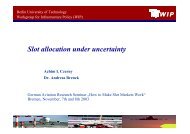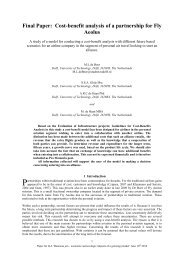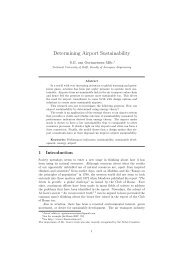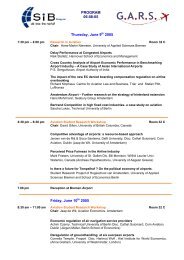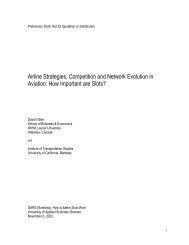1 Restructuring of the Value Chain of the European Ground ...
1 Restructuring of the Value Chain of the European Ground ...
1 Restructuring of the Value Chain of the European Ground ...
You also want an ePaper? Increase the reach of your titles
YUMPU automatically turns print PDFs into web optimized ePapers that Google loves.
As mentioned before, <strong>the</strong> market exchange along <strong>the</strong> supply chain may require<br />
contracts. Contracts are based on contractual law and define <strong>the</strong> conditions <strong>of</strong> exchange, in<br />
order to protect parties from opportunistic behavior, which is likely to be observed in <strong>the</strong> case<br />
<strong>of</strong> asset specificity and uncertainty after <strong>the</strong> contract is made. (Besanko, 2000; Ménard,<br />
2004). Transaction costs are “<strong>the</strong> costs <strong>of</strong> acquiring an input over and above <strong>the</strong> amount paid<br />
to <strong>the</strong> input supplier.” which include costs incurred before making <strong>the</strong> contracts (search and<br />
bargaining costs), opportunity cost <strong>of</strong> forgone transactions, costs incurred after making <strong>the</strong><br />
contracts (enforcing costs) as well as <strong>the</strong> opportunity cost <strong>of</strong> not choosing more pr<strong>of</strong>itable<br />
activities, if <strong>the</strong>re are any, by <strong>the</strong> end <strong>of</strong> or during <strong>the</strong> previous contract. (Ghosh and John,<br />
1999 ,Michael R. Baye, 2003,) As for TCE, developed by Williamson (1985, 991) it<br />
concerns determining <strong>the</strong> most efficient organization <strong>of</strong> exchange markets for intermediate<br />
goods and services. For this purpose, TCE examines governance structures from self handling<br />
and vertical integration to market coordination, hybrid organizations being in between, and<br />
having common properties with both extremes. Hybrid organizations are costly specialized<br />
governance structures, such as strategic alliances, joint ventures, and Japanese subcontracting<br />
networks, etc. (Besanko, 2000). They have three different forms: Weak (with short to midterm<br />
contracts), moderate (with long term contracts and reliable commitment) and strong form<br />
(e.g. Joint ventures or self-handling). As hybrid organizations get closer to strong form, <strong>the</strong><br />
duration and <strong>the</strong> complexity <strong>of</strong> <strong>the</strong> contracts; as well as <strong>the</strong> vertical control exerted by <strong>the</strong><br />
buyer on <strong>the</strong> supplier, increases.<br />
According to Williamson, <strong>the</strong> determinants <strong>of</strong> transaction costs are<br />
- <strong>the</strong> frequency <strong>of</strong> <strong>the</strong> contracts between two parties,<br />
- <strong>the</strong> specificity <strong>of</strong> investments made for <strong>the</strong> supply relationship,<br />
- -environmental or behavioral uncertainty,<br />
- -bounded rationality, and<br />
- -opportunistic behavior <strong>of</strong> individuals.<br />
Therefore <strong>the</strong>re are three main concerns <strong>of</strong> contactors, regarding <strong>the</strong> contracts along <strong>the</strong><br />
supply relationships. Ménard (2004).<br />
14






